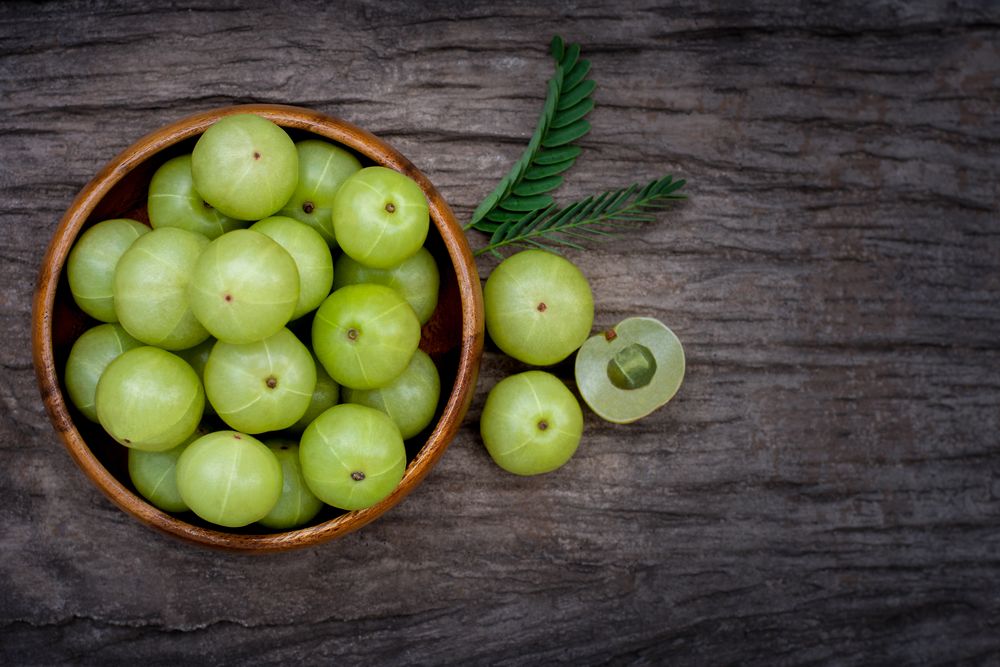Amla’s Health Advantages: During the winter season, amla steps in to provide the additional care needed for our body, skin, and hair.
What is Amla And Its Health Benefits?

It, also known as Indian gooseberry or Nelli, is renowned for its potent medicinal properties. The fruits of this versatile plant are utilized in the preparation of various medicinal formulations, effectively treating conditions such as anemia, sores, diarrhea, toothaches, and fevers. It is a rich source of Vitamin C. The green amla fruits are also utilized in the creation of pickles.
Additionally, it finds its way into a range of products including shampoo, hair oil, dye, tooth powder, and face creams. This branching tree, with an average height ranging from 8 to 18 meters, features glabrous branches. The greenish-yellow flowers come in two types: male and female. The pale-yellow fruits measure between 1.3 and 1.6 cm in diameter. Uttar Pradesh and Himachal Pradesh stand out as major it cultivation regions in India.
Amla’s Health Benefit
Boosting Immunity: Amla’s Superfood Strength
Winter woes? Amla’s got you covered! With eight times more vitamin C than oranges, double the antioxidants of acai berries, and 17 times that of pomegranates, it is a true immune-boosting powerhouse. Dive into its benefits for a robust immunity and improved metabolism. It not only tackles viral and bacterial ailments but also stands strong against health challenges like cancer and heart-related issues.
Battling Infections: Amla Powder’s Healing Touch
When it comes to fending off bacterial infections and the common cold, Amla takes the lead. A mix of Amla Powder and honey becomes your go-to remedy, providing relief from cough and cold when taken a few times a day. Beyond that, Amla aids in clearing respiratory passages, making it a soothing solution for bronchitis, cough, and other respiratory issues.
Gut Health Guru: Amla’s Alkaline Advantage
Struggling with constipation? It’s alkaline nature strengthens your digestive system, offering a natural remedy for constipation. Packed with fiber and anti-inflammatory properties, It’s powder becomes a go-to solution for addressing hyperacidity and preventing stomach ulcers.
Weight Wellness: Amla’s Metabolic Magic
Dreaming of shedding those extra pounds? It’s juice steps in as a weight management ally by enhancing digestion and metabolism. Consume it on an empty stomach or mix it with salt and pepper to curb your appetite, keeping you satisfied for longer periods. Its high fiber content acts as a natural laxative, aiding nutrient absorption.
Blood Purifier Extraordinaire: Amla’s Detox Dynamics
Experience the blood-purifying prowess of Amla! Loaded with vitamin C, it strengthens blood vessels, acts as an antioxidant, and efficiently detoxifies the body. Blend It’s powder with honey or jaggery for a natural blood-purifying elixir that may boost hemoglobin levels with regular consumption.
Chronic Condition Manager: Amla’s Medicinal Might
From diabetes to heart disease, Amla proves to be a versatile ally in managing chronic health conditions. Embrace the medicinal uses of this superfood to navigate the challenges of conditions like high cholesterol, asthma, and cancer.
Visionary Support: Amla’s Eye-Catching Benefits
Enhance your vision naturally with Amla! Packed with carotene, it contributes to overall eye health, addressing issues like cataracts and intraocular tension while preventing eye irritation and discomfort.
Pain Relief Partner: Amla’s Anti-Inflammatory Soothe
Bid farewell to daily pains! Amla’s anti-inflammatory properties offer relief from arthritis, joint aches, and painful mouth ulcers. Dilute Amla juice for gargling to ease mouth ulcers and embrace regular relief.
Hair Hero: Amla’s Tonic for Tresses
Say goodbye to dandruff and hair loss! Amla proves to be a tonic for your tresses, strengthening hair follicles, improving blood circulation to the scalp, and promoting shiny, strong hair.
Skin Savior: Amla’s Radiance Ritual
Elevate your skincare routine with Amla! Beyond imparting a natural glow, it keeps the skin hydrated and healthy, doubling as a superfood with its anti-aging properties.
Cold Buster: Amla’s Vitamin C Symphony
Combat the common cold with Amla, the richest natural source of vitamin C. Its immunosuppressive and antioxidant properties contribute to enhanced immune system performance.
Heart Health Partner: Amla’s Cholesterol Check
Maintain cholesterol levels with Amla! It aids in lowering bad cholesterol, preventing fat accumulation in arteries and veins, reducing the risk of atherosclerosis, and promoting overall cardiovascular health.
Facts of Gooseberry
| The skin of the gooseberry is covered with veins that can help to soften the hair. |
| Each gooseberry fruit contains 15 to 30 small seeds. |
| This fruit has loads of vitamin C, including minerals such as calcium, phosphorus, manganese, and copper. |
| Amla Nutrition Facts | |
|---|---|
| Sodium | 1.5 mg |
| Potassium | 297 mg |
| Total Carbohydrates | 15 mg |
| Total Fat | 0.9 mg |
| Protein | 1.3 grams |
| Dietary Fiber | 6.5 grams |
How to take Gooseberry Juice?
For optimal benefits, kickstart your day with gooseberry juice. Take a small portion (20-30 ml) of gooseberry juice diluted in a glass of water. If you find it too strong, consider adding a bit of lemon juice and honey to enhance the taste. Combine gooseberry juice with Jamun (Indian blackberry) and karela (bitter gourd) juice for better diabetes management. If you’re dealing with high cholesterol levels and hair issues, a blend of gooseberry juice and aloe vera juice works wonders. Taking gooseberry juice before bedtime is beneficial; it aids in detoxifying the adverse effects of junk food.
Frequently Asked Questions (FAQs)
1. Is Amla harmful to health?
While it may not have any serious implications, it is always advisable to consult your doctor before you consume this fruit for good health. Can make the cold worse-Amla is known as a natural coolant and can make your symptoms of cold worse. To a large extent, it is believed that the body temperature is lower.
2. What is the best time to eat Amla?
The best time to consume amla is early in the morning, especially during the winters when the temperature dips. In addition to the purification of the colon, it removes excess toxins from the body and is a rich source of natural vitamin C and calcium.
3. Is Amla bad for kidney?
Extra sodium causes a loss of calcium in the urine, which puts the patient at risk of developing another stone. At the same time, too much calcium from foods such as spinach, green chilli, tomatoes, amla, chico, cashew nuts, cucumber, mushroom, and brinjal in the diet is also harmful.
4. Is Amla good for hair?
Amla, like curry leaves, is a proven hair tonic. It gradually decreases greying, prevents dandruff, strengthens hair follicles, and increases blood circulation to the scalp, thus improving hair growth. Amla also acts as a natural conditioner that gives you soft shimmering locks.
5. Can Amla regrow lost hair?
Amla or Indian gooseberry can effectively treat hair loss. This edible fruit is considered a miracle cure for hair care. It stimulates hair growth and improves hair quality. It contains calcium, which promotes healthy hair.
6. Can Amla reduce weight?
It helps keep your digestive system on track throughout the day and accelerates your metabolism. A good metabolism is able to burn more calories efficiently. It is often suggested to drink amla juice on an empty stomach for better weight management.
7. Does Amla reduce belly fat?
The reason Amla can be an excellent belly fat-fighting superfood is because of its nutrients. Vitamin C gives you immunity to fight against toxins and inflammation and boost metabolism.
8. Does Amla cause weight gain?
Adding amla in your daily diet increases the digestion rate and reduces the build-up of toxins that may lead to weight gain.
For breaking news and live news updates, . Read more on Latest Health News.

